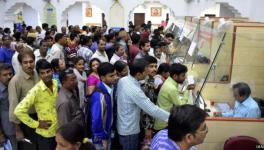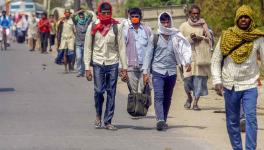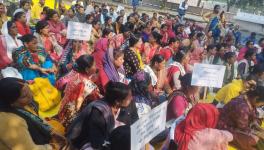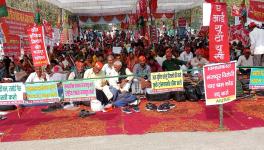How Localised Public Health Strategies Can Help Tackle Covid-19 Effectively
Representational use only.
Even after about one-and-a-half years of struggling with the COVID-19 pandemic, a comprehensive and effective public health strategy to deal with the crisis is missing in India. The lack of such a strategy led to a massive loss of lives during early 2021, and the impact's actual magnitude is still unfolding. Moreover, the Indian authorities continue to look at the spread of COVID-19 mainly in terms of "first wave and second wave" and now the impending "third wave", as if there is a single pattern of the disease's spread for the entire country.
A closer look at the data clearly shows that an aggregate macro-level analysis is not very useful in studying and responding to the pattern of COVID-19 waves. This is because the pattern and trajectory of COVID-19 have differed from region to region. For instance, in India, the pattern of cases in Uttar Pradesh is quite different from that in Delhi. For large states such as Maharashtra, even districts and urban centres behave differently.
In 2020, the first response of the Indian government to deal with the public health crisis was to impose a sudden country-wide lockdown. However, the strategy failed in controlling the spread of the pandemic and led to an unprecedented humanitarian crisis in the form of the exodus of scores of migrant workers from cities to villages.
Studying the differential patterns in morbidity at a disaggregated level, thus, becomes a crucial element in devising a sound public health response. As we analyse below, the patterns of disease spread have differed based on factors such as the level of urbanisation, demographic composition, and geographic location, among others.
Moreover, for a prompt public health response, the more important thing is that the course of a particular wave can be anticipated in advance. This prediction would be crucial to put the necessary public health measures in place and minimise losses.
A recent study in STAT, an online news portal covering health and medicine, suggests alternative ways of assessing the intensity of a wave. Studying the trend of COVID-19 cases in the United States (US), this analysis shows that tracking the weekly average of new cases tells us how fast case counts are increasing or decreasing and also the magnitude of each wave. However, it fails to show the rate at which the number of new cases is speeding up or slowing down – equivalent to the concept of acceleration. We adapt this analysis for the case of India and see the changes in the weekly average of new cases.
Varying Pandemic Trajectory across States
A look at the COVID-19 spread patterns at the disaggregated level of different regions across the country and states tells us that the trajectory of the pandemic for each state has differed. We have looked at patterns at the district level in Maharashtra and found that there are variations within a state. Such variations in the pattern indicate the need for devising appropriate public health strategies specific to each case. Although we have stopped at the level of districts here, public health interventions need to be even more localised.
We have divided the Indian states into three clusters: Cluster 1 – States with Lower Urbanisation; Cluster 2 – States with Higher Urbanisation; Cluster 3 – North-eastern and Hilly States. States have been clustered based on the level of urbanisation and also, to some extent, by geographical proximity. We have taken the 14-day average of daily cases for the analysis.
The patterns of COVID-19 spread within each cluster vary. If we compare states across these clusters, the variations are more pronounced.
Cluster 1 – States with Lower Urbanisation
In this cluster, seven states include Bihar, Chhattisgarh, Madhya Pradesh, Odisha, Punjab, Rajasthan, and Uttar Pradesh. Most of these states show a similar pattern of disease spread over the months in 2020 and then in 2021 – first peaking around September and October in 2020 and then in May and June 2021.
However, if we compare UP and Odisha, we see that UP reached a peak earlier in both phases than Odisha. In 2021, when the daily cases were declining during May-end, cases in Odisha were at their peak. Since June 2021, the decline in daily cases in Odisha has been much slower than the sharper decline in UP.
If we juxtapose the 14-day average of daily cases to the change in this measure (Figure 1b), we get to know whether the particular wave is getting worse. If we look at the comparative line graphs for UP in Figure 1a and Figure 1b, we see that the pace at which the new cases were changing reached its peak well before the daily cases were at their peak. The daily cases started declining only when the change in new cases was at zero. Thus, the trajectory of the pace of change in daily cases can indicate how long the increase or decrease in the daily cases would sustain.
With such patterns visible, the public health strategies could have been designed to detect the rise in cases across some states, which would have helped contain the subsequent rise in cases in other states.
In one of the papers in the Indian Journal of Medical Research 2020, Mandal et al. suggest the use of symptomatic surveillance as the primary public health strategy to detect and respond in the most effective and timely manner. As it happened during the second peak in 2021, this strategy of symptomatic surveillance could have been particularly effective as the increasing numbers made the use of laboratory testing to confirm each case difficult.
Contrary to such a simple public health strategy, the surveillance had been almost abandoned in India. Due to a staff shortage, public hospitals such as AIIMS were forced to stop contact tracing. In addition, even the testing numbers have been continuously declining.
Cluster 2 – States with Higher Urbanisation
In this cluster, we have taken those relatively more urbanised states – Delhi, Gujarat, Karnataka, Kerala, Maharashtra, Tamil Nadu, and West Bengal. In this cluster, while daily cases in Kerala and Karnataka have followed a similar trajectory, Delhi followed a different path. It experienced about four peaks with three muted ones during the first wave in end-June, mid-September and mid-November 2020. In May 2021, Delhi experienced its second wave peak. At the beginning of August 2021, while daily cases in Maharashtra declined at a slower pace, Kerala reached its third peak.
Juxtaposing the 14-day average of daily cases and the change in the 14-day average, we see that during the second wave in Maharashtra, the pace of change in daily cases reached its peak on April 13, 2021 (Figure 2b). At this time, the daily cases kept on increasing. The Average Daily Cases (Figure 2a) reached a peak on April 30, 2021, when the pace of change was zero, as seen in Figure 2b.
While Kerala has continued to employ public health measures such as mass testing and also ensured strict adherence to quarantining, many of the states have given up on these measures.
Cluster 3 – North-eastern & Hill States
Cluster 3 has some of the North-eastern States and other hill states, including Assam, Himachal Pradesh, Manipur, Mizoram, Tripura, and Uttarakhand.
During the first wave in 2020, while Assam experienced three peaks in quick succession in August, September and October 2020, Uttarakhand experienced only one peak in September 2020. On the other hand, in Manipur, the intensity of the pandemic was muted during the first wave, but early June and end-July 2021 have seen two quick peaks. These peaks were reached when Covid cases in Uttarakhand and Assam were on a decline (Figure 3a).
Looking at Figures 3a and 3b together, we can see similar patterns as in other states. The trajectory of the wave in terms of daily cases can be anticipated by looking at the trajectory of the pattern of change in the average daily cases.
Such metrics may help in a more informed and quicker public health response from the authorities. While in the first phase during 2020, the COVID-19 pandemic had not ravaged the North-eastern and other hill states except Assam, 2021 has seen a rise in the number of cases in states such as Manipur, Uttarakhand and Himachal Pradesh. In fact, Manipur has seen a repeated rise in the number of cases over the recent months. These could have been contained had lessons been learnt from other states' experience and appropriate public health measures were initiated.
More Disaggregation Through Select Districts in Maharashtra
A look at a more disaggregated level of districts shows further differences in the patterns of COVID-19 progression. In Amaravati, a rural district, daily cases peaked in September 2020 during the first wave and then in March and May 2021. Thane, an urban district, experienced two peaks in July and September 2020 and then, after tapering off, the daily cases sharply increased and peaked in April 2021. Kolhapur has already seen three peaks in quick successions in May, June and July 2021.
While urban districts were affected first, the rural districts saw a surge in cases with a lag. Had public health measures been applied well in advance in these rural districts, the impact of the pandemic would have been subdued. Mandal et al. (2020) suggest such public health measures as active engagement with the community, intensive surveillance for symptoms, followed by testing and quarantine.
Strategies like the engagement of local volunteers and community-based organisations can support the public health system in dealing with the crisis. The involvement of local bodies (Panchayati Raj Institutions), especially in rural areas, can be one effective public health strategy, as has been evident in Kerala.
With the threat of an impending surge in COVID-19 cases as part of the "third wave" being predicted, state authorities – both at the Centre and at the level of states – need to respond proactively by devising appropriate and effective public health strategies. The experience across states and select districts within Maharashtra shows that the patterns of disease progression in the COVID-19 pandemic have been varying. For a more informed public health strategy, a more localised response to the problem is required. Authorities can employ metrics like the pace of change in daily cases to study the likely trajectory of the pandemic in each area and take appropriate measures well in advance. Thus, the impact of the pandemic can be tackled early on and in a better and more informed manner.
(With data inputs from Peeyush Sharma)
Get the latest reports & analysis with people's perspective on Protests, movements & deep analytical videos, discussions of the current affairs in your Telegram app. Subscribe to NewsClick's Telegram channel & get Real-Time updates on stories, as they get published on our website.
























